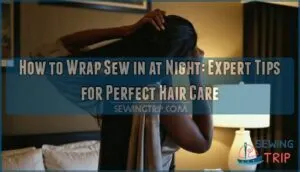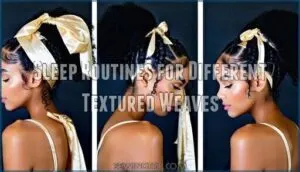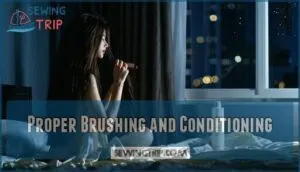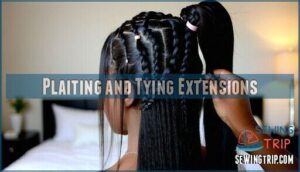This site is supported by our readers. We may earn a commission, at no cost to you, if you purchase through links.

Start by gently brushing your sew-in extensions from ends to roots, removing any tangles that accumulated during the day. Next, wrap your hair in circular motions around your head, starting from one ear and working toward the other.
This technique keeps everything smooth and prevents that dreaded bedhead look. Secure the wrap with bobby pins, then cover with a silk scarf or bonnet to reduce friction against your pillowcase.
Think of it as tucking your hair in for a good night’s sleep. The right nighttime routine protects your investment and guarantees you’ll wake up looking effortlessly put-together.
Table Of Contents
Key Takeaways
- Start with gentle detangling – You’ll want to brush your sew-in from ends to roots with a wide-tooth comb before wrapping, removing any tangles that have built up during the day to prevent breakage and matting overnight.
- Wrap in circular motions around your head – You should start from one ear and work toward the other, securing each section with bobby pins to keep everything smooth and prevent that dreaded bedhead look.
- Cover with silk or satin protection – You’ll need to use a silk scarf or satin bonnet after wrapping to reduce friction against your pillowcase, which protects your investment and maintains your style’s integrity.
- Customize your routine for your weave’s texture – You should adjust your nighttime care based on whether you have curly, wavy, or straight extensions, using techniques like the pineapple method for curls or sectioned braids for waves.
How to Maintain Weave at Night
You’ve spent good money on your sew-in weave, so don’t let a night of tossing and turning turn it into a tangled mess that’ll have you questioning your life choices.
The secret to waking up with gorgeous hair lies in mastering three simple nighttime habits.
These habits include proper detangling and moisturizing, choosing the right protective wrap or bonnet, and tailoring your sleep routine to match your weave’s specific texture.
Detangling and Moisturizing
Think of your nighttime routine as giving your hair a gentle spa treatment. Start detangling with a wide-tooth comb, working from ends to roots—this comb selection prevents breakage and stress.
Your weave deserves royal treatment—transform bedtime chaos into silky morning magic with one simple routine.
Apply your chosen moisturizer through product application, focusing on scalp health and sew in care. A quality comb selection is key for hair health.
Overnight hydration works magic while you sleep, so don’t skip this step. Proper moisture sealing keeps your weave fresh and manageable.
Your hair wrap protects this investment, ensuring you wake up with gorgeous, tangle-free locks ready for styling.
Choosing The Right Wrap or Bonnet
Your hair wrap choice can make or break your sew in care. The right satin bonnet or silk scarf transforms your nighttime routine from disaster to dream.
Material Benefits for Your Sew-In:
- Satin bonnets reduce friction while you sleep, preventing breakage and maintaining your style’s bounce
- Silk scarves offer wrap styles that accommodate different head sizes with secure fit options
- Comfort prioritization guarantees texture harmony between your natural hair and extensions throughout the night
To keep your sew-in fresh, remember to wash hair weekly.
Sleep Routines for Different Textured Weaves
Different textures demand their own nighttime dance, and mastering these personalized routines will transform your morning hair game completely.
Your weave deserves a personalized nighttime ritual—treat each texture like the crown jewel it is.
Your weave’s texture determines everything about how you should sleep with sew in extensions. Curly weave care starts with the pineapple method—gather those spirals into a high, loose ponytail, then secure with a satin bonnet to maintain bounce. Wavy weave care requires sectioning your waves into 4-6 loose braids before covering with your silk scarf. Straight weave care involves wrapping strands around your head in alternating directions, creating a protective cocoon that prevents tangling.
Understanding textured hair needs is essential for maintaining its health and appearance.
Here’s your texture-specific nighttime routine breakdown:
- Curly textures: Use the pineapple method with multiple loose twists
- Wavy patterns: Create sectioned braids with silk-covered bands
- Straight styles: Wrap in circular motions around your head
- All textures: Always braid before sleep for ultimate protection
Remember, your hair wrap technique should match your weave’s personality—treat each texture like the unique beauty it is.
Importance of Securely Sleeping With Long Hair Extensions
When you’ve invested in beautiful long hair extensions, protecting them during sleep becomes just as essential as your daytime styling routine.
Since tossing and turning can quickly transform your gorgeous locks into a tangled nightmare, you’ll need to take precautions to prevent damage.
You’ll need to secure your extensions properly before bed to prevent shedding, matting, and breakage that can cut your extension’s lifespan in half and leave you with costly replacements.
Preventing Tangling and Shedding
Your extensions deserve proper TLC to avoid morning mayhem.
Start with nightly braiding—this simple trick prevents tangling and reduces shedding substantially.
Before bed, gently brush through your weave material to remove product buildup and knots.
Apply a lightweight serum application to mid-lengths and ends for added protection.
Secure everything with a loose braid, then cover with a silk scarf or satin bonnet for friction reduction.
This nighttime routine keeps your sew in maintenance game strong while you sleep peacefully, with a strong sew in.
Proper Brushing and Conditioning
Before bedtime becomes a tangled mess, establishing proper brushing and conditioning creates the foundation for healthy sew in maintenance.
Your nighttime routine should include these essential steps:
- Detangle gently using wide-tooth combs or paddle brush types from ends upward
- Apply lightweight conditioner types to mid-lengths, avoiding bonds completely
- Remove product buildup with gentle brushing motions for better scalp health
- Seal moisture using hair wrapping technique before sleep
This conditioning approach prevents breakage while maintaining extension integrity.
To keep your sew-in fresh, consider using sulfate-free shampoo regularly.
Plaiting and Tying Extensions
After brushing and conditioning your extensions, plaiting becomes your secret weapon for sew in preservation.
Start by sectioning your hair into manageable parts. Create loose braids using gentle tension control – tight plaits spell trouble for your scalp and weave longevity. Secure each braid with silk scrunchies, avoiding harsh elastics that snag.
One should consider the braiding techniques to keep strands taut and neat. This protective style nighttime care routine transforms your hair wrap game completely.
| Braid Size | Best For | Tension Level |
|---|---|---|
| Large sections | Thick extensions | Light pressure |
| Medium sections | Mixed textures | Moderate grip |
| Small sections | Fine hair | Gentle hold |
General Maintenance Tips for Human Hair Extensions
You’ve mastered the nighttime wrapping routine, but keeping your sew-in extensions looking fresh requires consistent daily care that goes beyond bedtime prep.
The right maintenance habits, from choosing quality conditioners to perfecting your morning routine, will help your investment last longer and look salon-fresh every day.
Using Suitable Conditioner
Your nighttime care routine isn’t complete without the right conditioner. Look for conditioner ingredients like shea butter and natural oils that nourish without weighing down your sew-in.
Master these application techniques: focus on mid-lengths and ends, avoiding the bonds entirely. Leave-in options work wonderfully for overnight treatments.
Consider conditioner frequency—every three days prevents dryness while avoiding buildup. Quality hair wrapping tips include applying conditioner before your hair wrap routine.
This sew-in preservation method keeps extensions soft and manageable for morning styling. Many users find success with a specific sew-in conditioner.
Removing Braids in The Morning
Morning Detangling becomes a breeze when you’ve properly braided your sew in overnight. Gently remove each braid to reveal smooth, vibrant hair that’s ready for styling.
This hair wrapping technique prevents overnight damage and creates the perfect foundation for your day.
Here’s your morning routine for sewin weave care:
- Start gentle – Slowly unbraid each section to avoid pulling
- Check for tangles – Address any knots with a wide-tooth comb
- Style refresh – Lightly brush for instant volume boost
- Finish strong – Apply light serum for frizz reduction and curl definition
Quality and Options
After perfecting your morning routine, choosing quality hair extensions becomes your next winning move.
Virgin hair offers unprocessed excellence, while Remy maintains aligned cuticles for tangle-free days.
Your weave texture determines which satin materials work best—silk pillowcases complement any hair extension type.
Consider bonnet styles that match your sleeping habits, and explore various hair wrap options.
To keep your sew-in fresh, wash hair weekly for ideal results.
Remember, investing in premium materials pays off through extended wear and easier maintenance using proper sew in tips.
Sleep and Hair Care Experts
You’ll discover expert insights that transform your nighttime hair routine from guesswork into a science-backed approach.
Leading professionals like Gregorio Ruggeri and sleep researcher Tiara share proven techniques that’ll keep your sew-in looking fresh while you catch those much-needed Z’s.
Gregorio Ruggeri’s Approach to Hair Care
Drawing from two decades of luxury salon experience, Gregorio Ruggeri’s philosophy centers on scalp health as your foundation for stunning results.
His holistic approach combines product recommendations with client education, emphasizing sulfate-free formulas that won’t strip your hair weave wrapping routine.
When you’re mastering nighttime hair care, Ruggeri’s sew in tips focus on gentle handling and the silk scarf method for superior protection.
Tiara’s Focus on Sleep Research
Tiara’s groundbreaking sleep research reveals how your sleep position directly impacts weave longevity and scalp health.
Her studies show that back sleeping with proper hair wrap techniques enhances product absorption while maximizing friction reduction.
You’ll discover that silk scarf method and satin bonnet use aren’t just protective measures—they’re scientifically proven strategies for sew in longevity.
With proper maintenance, your stylist’s quality hair scissors will last longer.
Tiara’s findings transform nighttime hair care from guesswork into precision, giving you confidence that every night’s rest strengthens your investment.
Frequently Asked Questions (FAQs)
How do you wrap hair at night?
Start by gently detangling your hair with a wide-tooth comb from ends to roots.
Wrap sections around your head in circular motions, securing with bobby pins, then cover with a silk scarf for protection.
Should You Wrap Your Hair for sleeping?
Wrapping your sew-in before bed is essential for maintaining your style and protecting your investment. It prevents tangles, reduces frizz, and keeps your weave looking fresh longer.
Should you wrap your hair before wrapping it?
Yes, you should always prep your weave before wrapping it for the night.
Gently detangle with a wide-tooth comb, apply light moisturizer to prevent dryness.
Then wrap securely for beautiful morning results.
How do I wrap my hair with a scarf?
Apparently, rocket science involves fewer steps than proper scarf wrapping!
Place your scarf at your hairline, wrap it around your head in circular motions, then tie the ends securely at the nape for protection.
How do you wrap hair in a bobby pin?
First, detangle your weave gently with a wide-tooth comb.
Section hair into manageable parts, then wrap each section around your head in circular motions.
Secure the wrapped hair firmly using bobby pins placed strategically along the hairline, following complete concepts for a neat finish.
Should you use a silk wrap or a satin cap?
Like choosing between two trusted friends, both silk wraps and satin caps protect your sew-in beautifully.
You’ll find silk offers superior breathability and temperature control, while satin caps provide easier application and stay put better during sleep, making satin caps a preferable choice for some users.
Can you swim with sew-in extensions?
Swimming with sew-in extensions isn’t recommended since chlorine and saltwater can damage the hair and loosen tracks.
If you must swim, wear a swim cap and rinse immediately afterward with fresh water.
How often should you wash sew-ins?
Think of your sew-in like a favorite shirt—you wouldn’t wash it daily, right?
You should wash your sew-in every 1-2 weeks to maintain freshness without over-manipulating the hair and causing damage.
What products damage sew-in weave bonds?
Heavy oils, alcohol-based products, and petroleum-based substances can weaken your sew-in bonds.
You’ll want to avoid hair food, thick creams, and harsh styling gels that create buildup and compromise the adhesive holding your extensions securely.
When should sew-ins be professionally removed?
Before telegrams became obsolete, hairstylists knew timing was everything.
You should professionally remove your sew-in after 6-8 weeks to prevent matting, breakage, and scalp damage.
Don’t wait longer—your natural hair’s health depends on it, and removing it on time is crucial for preventing breakage.
Conclusion
Beautiful hair deserves beautiful dreams, and mastering how to wrap sew in at night transforms your morning routine from chaotic to effortless.
You’ve learned the essential steps: gentle detangling, proper wrapping techniques, and protective covering with silk accessories.
These simple habits protect your investment while you sleep, ensuring you wake up with smooth, manageable hair that’s ready for styling.
Remember, consistency is key—make these nighttime rituals part of your regular routine for consistently gorgeous results, and always prioritize protective measures to maintain your hair’s health, which is essential for beautiful hair.
- https://usahair.com/blog/how-to-sleep-with-sew-in-hair-extensions-tips-to-prevent-damage.html?srsltid=AfmBOopkWi8VhAalf0b4J9XSoO26pQbG1917AovyH1MAf5oGC_AZdE1u
- https://www.quora.com/How-do-you-sleep-with-sew-in-hair-extensions
- https://www.tiktok.com/discover/how-to-protect-sew-in-closure-while-sleep
- https://slrawvirginhair.com/blogs/hair-extension-after-care/how-to-preserve-your-hair-extensions-at-night-beauty-hack?srsltid=AfmBOoomGcUUeIMYmngUQn3l3cYZmrZGceYiHlEb-WDjVOP5Avaj7DVJ
- https://www.covetandmane.com/guides/how-to-sleep-with-your-hair-extensions














